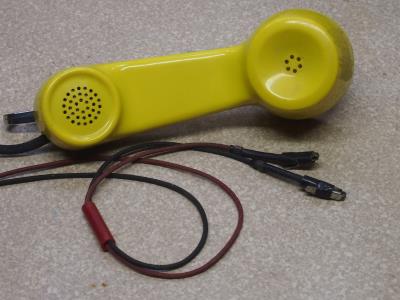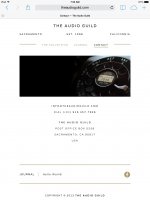I'm hooked.
Speaker Bullets = $5,500.00
Interconnect Bullets = $2,195.00
Holographic Power Source = $5,495.00
Total = $13,190.00
My first step into Hi-Fi.
Marketing tip: drop "Bullets".
Audiophools seem to like "Bullets".
There was a company called Eichmann(!) making overpriced RCA plugs called 'Bullets'. They kept the name Bullets but changed Eichmann to ETI.
forgot the link!
Paraphernalia
Back on topic!
Small Greek manufacturer who is not afraid to have fun with the subject! (No affiliation).
on the road
Paraphernalia
Thank you.
Yes, very good work indeed.
However if I may make a comment, your website doesn't work well at all on my iPad.
se
Attachments
Drain damp reflect?
What's up with all the different tech on cones, or footers and shelving?
What do these things do that a well designed component's own feet aren't doing?
So far I've heard that soft pucks isolate a component from exterior vibrations, but won't drain interior ones.
Also heard shelves should be stone and massive, to provide a sink for transformer buzz.
Heard granite should be used, as it's extremely rigid.
Heard granite should be avoided, as it's crystalline structure can store enough enough electrical potential to interfere with circuit boards.
Also heard plywood shelves are best to avoid reflections and delayed energy storage/release.
Have also been told constrained layers are best, with the component cone shelf interface materials to be hard materials with cones pointed up. And with cones pointed down.
Also heard this is wrong, because the noise will be reflected back into your components.
Even had a salesman tell me to go to the beach and gather snail shells; this gives a golden ratio,light ,rigid cone.
Anybody have empirical experience/ preferences with cone, shelf, or other footer experiments?
So far I'm just using oak 40 mm shelving on furniture extruded aluminum pillars for a stand, happy with its looks, should I be changing things up?
What's up with all the different tech on cones, or footers and shelving?
What do these things do that a well designed component's own feet aren't doing?
So far I've heard that soft pucks isolate a component from exterior vibrations, but won't drain interior ones.
Also heard shelves should be stone and massive, to provide a sink for transformer buzz.
Heard granite should be used, as it's extremely rigid.
Heard granite should be avoided, as it's crystalline structure can store enough enough electrical potential to interfere with circuit boards.
Also heard plywood shelves are best to avoid reflections and delayed energy storage/release.
Have also been told constrained layers are best, with the component cone shelf interface materials to be hard materials with cones pointed up. And with cones pointed down.
Also heard this is wrong, because the noise will be reflected back into your components.
Even had a salesman tell me to go to the beach and gather snail shells; this gives a golden ratio,light ,rigid cone.
Anybody have empirical experience/ preferences with cone, shelf, or other footer experiments?
So far I'm just using oak 40 mm shelving on furniture extruded aluminum pillars for a stand, happy with its looks, should I be changing things up?
What's up with all the different tech on cones, or footers and shelving?
It doesn't make any difference for my electronics, but there is some for my turntable. And the latter is different from room to room. Hardware store stuff is, IMO, the best approach, avoiding the hilariously priced "audiophile" versions.
Yes, very good work indeed.
However if I may make a comment, your website doesn't work well at all on my iPad.
se
Thank you,
Yeah, I know it doesn't work well on mobile browers. When I made the site in 05 I used frames. Even then I knew better, but I thought it was so cool to have my monogram appear at the lower left corner no matter the window size. Mobile doesn't support frames. Since then the computer with Dreamweaver died. Anybody know of a good free website design program? One that, like Dreamweaver, keeps you close to the code.
Last edited:
Yeah, I know it doesn't work well on mobile browers. When I made the site in 05 I used frames. Even then I knew better, but I thought it was so cool to have my monogram appear at the lower left corner no matter the window size. Mobile doesn't support frames. Since then the computer with Dreamweaver died. Anybody know of a good free website design program? One that, like Dreamweaver, keeps you close to the code.
I did our original website with straight HTML written in Notepad, which I guess is about as close to the code as you can get. But for the new website I'm working on, I decided I didn't want to be so close to the code and opted for Squarespace, which I really like. You work within a template, but you can also do custom CSS and whatnot if you've got the chops for that sort of thing which I don't and have no real interest in.
Squarespace has carved out a bit of a niche by aiming primarily at the creatives who want a nice website without much of a hassle.
se
Steve, I looked at your The Audio Guild blog. I love your retro design choices. Beautiful. I used to work for Ma Bell, back when she was THE phone company. Those big engraved Bakelite control panels. So cool.
Thank you for the kind words.
The control panels are actually Ebonite (a trademarked word for hard rubber). One of my inspirations for the design were some old crystal radio sets from the 1920s that I saw on the J.C. Verdier radio museum website. I asked what the top plates of those old radios were (as well as other electronics of the time). I was told it was Ebonite, but that no one made it in sheet form anymore. But eventually a found a small place in Tokyo that was still making it in sheet form and since I wanted to stay true to the inspiration, I was able to do some proper Ebonite top plates.
The knob and the binding posts do use Bakelite though.
And yeah Ma Bell was indeed THE phone company. You didn't even own your phone back in the day. You only leased it. Which meant if it broke, they had to come out and fix it. So the order of the day was make 'em so they don't break.
I have an old Western Electric CD500 desk phone that was made in 1957 (in fact in May of '57). Has a heavy duty coiled cord and metal dial plate. Still works great, and sounds better than most people's modern cell phones.
se
I disagree with SY about the electronics, but the answer is to use whatever is at hand, as cheap as you can get it. The goal is zero vibration of the component case and internals, from whatever causes. I strongly favour intelligent use of damping materials, turning any vibration into heat - using other approaches may merely shift the vibration from one place to another, or the frequency of it. Deadness is what you want, like being in an anechoic chamber for the ears.So far I'm just using oak 40 mm shelving on furniture extruded aluminum pillars for a stand, happy with its looks, should I be changing things up?
HTML on Notepad. Like coding machine language without an assembler.  I've done more of that than I care to remember. I'll check out Squarespace. Thanks.
I've done more of that than I care to remember. I'll check out Squarespace. Thanks.
I got rid of all my old Western Electric desk phones. As well as my land line. I kept this out of sentiment. Braided cable and everything. There is a switch that disconnects the microphone. Contrary to popular belief, when in monitor mode there is no telltale click when you hook onto a live line.

I read the entire blog, fascinating. Good luck with the amp. When does the website go live?
I got rid of all my old Western Electric desk phones. As well as my land line. I kept this out of sentiment. Braided cable and everything. There is a switch that disconnects the microphone. Contrary to popular belief, when in monitor mode there is no telltale click when you hook onto a live line.

I read the entire blog, fascinating. Good luck with the amp. When does the website go live?
Agreed.I disagree with SY about the electronics, but the answer is to use whatever is at hand, as cheap as you can get it. The goal is zero vibration of the component case and internals, from whatever causes. I strongly favour intelligent use of damping materials, turning any vibration into heat - using other approaches may merely shift the vibration from one place to another, or the frequency of it. Deadness is what you want, like being in an anechoic chamber for the ears.
I have tried various experiments with isolation/damping.
All the below ingredients were scrounged/free.
First was to place a sheet of kitchen stone on top of four car engine valve (Ford V8) springs.
Then the CD player.
Then a layer of concrete slab expansion joint foam.
Then another sheet of Kitchen stone.
This whole (very heavy) assembly floated very nicely and had a very low natural resonance frequency....less than two Hz.
The objective (knuckle test) result was that the whole assembly (and CDP panels) was as dead as an old hardwood fence post.
The subjective resultant was quite spectacularly good....with a reasonably standard CDP, a whole spectrum of subjective audio junk was eliminated.
I fully expect that this is due to dramatically lowered focus/tracking servo currents, with consequent lowering of servo stage/audio stage/earthing/power supply interactions.
Dan.
Last edited:
Back in my telecoms day it was called a Buttinski.I kept this out of sentiment. Braided cable and everything. There is a switch that disconnects the microphone. Contrary to popular belief, when in monitor mode there is no telltale click when you hook onto a live line.

I always marvelled at that name
Dan.
HTML on Notepad. Like coding machine language without an assembler.
Except that HTML is a hell if a lot simpler than machine code.
I've done more of that than I care to remember.
I did a tiny bit of that for 6502 back when I had an Apple ][+. Never again. I'll leave that to others.
I got rid of all my old Western Electric desk phones. As well as my land line.
That's becoming more and more common now, and I can't tell you how much that frustrates me. Most people's cells sound like absolute crap and I'm really tired of having to strain to understand them. One friend's cell and cell service is particularly bad, and to make it even worse, he seems to only call me when he's on the road.
I'll give up my land line when they pry it from my cold, dead hands.
I kept this out of sentiment. Braided cable and everything. There is a switch that disconnects the microphone. Contrary to popular belief, when in monitor mode there is no telltale click when you hook onto a live line.
Nice! I'd have killed for one of those back when I was a kid. Oh the mischief I could have got into with one of those.

I read the entire blog, fascinating. Good luck with the amp.
Thank you!
When does the website go live?
Hopefully when the amp's ready to go. But still have to re- shoot all the cable stuff.
Here's the contact page of the new site, featuring my CD500. Fortunately my exchange is an old one so I was able to use the same exchange name that was used here in Sacramento back in the day. I even printed it on some end paper I scavenged from a book that was published back in the '50s (nothing looks more like old paper than old paper). Would love to have had it offset print instead of using my inkjet, but that perhaps would have been going a little too far.
se
Attachments
Butt-inski
Just repaired the mic of my son's cell phone, thought I was going nuts.
(where I originate from, the B-word means it sucks)
What a cool phone! I never thought that it existed, except for the FBI, or someone similar.
Every lineman had one of those hanging off their tool belt. They still do in fact, except they're touchtone now.
se
- Status
- Not open for further replies.
- Home
- Member Areas
- The Lounge
- Funniest snake oil theories

